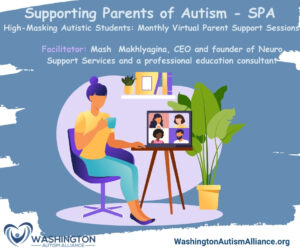Introduction
School avoidance in autistic children is a complex issue with multiple underlying causes. It’s crucial to approach this with empathy and a focus on identifying and addressing the root of the problem. Join Educational Consultant Mash Makhlyagina as they take on school avoidance in the upcoming virtual WAA SPA (Supporting Parents of Autism) on Monday May 12th 5-7 pm on TEAMs.

Common Reasons for School Avoidance
- Sensory overload
- Social anxiety
- Difficulty with routine changes
- Communication challenges
- Bullying or social isolation
- Anxiety related to academic demands
Strategies to Support School Attendance
Create a Supportive Environment
- Work closely with the school to develop an Individualized Education Plan (IEP) or 504 plan that addresses the child’s specific needs.
- Implement sensory accommodations, such as quiet spaces or noise-canceling headphones.
- Ensure clear and consistent communication between home and school.
Address Anxiety and Stress
- Use visual supports to communicate schedules and expectations.
- Practice relaxation techniques like deep breathing or mindfulness.
- Provide opportunities for movement breaks throughout the day.
Improve Social Interactions
- Facilitate social skills training or peer support groups.
- Educate classmates about autism to promote understanding and acceptance.
- Intervene promptly and effectively in cases of bullying.
Collaborate with Professionals
- Seek guidance from therapists or counselors specializing in autism.
- Consult with behavioral analysts to develop strategies for managing challenging behaviors.
- Involve medical professionals to rule out any underlying health concerns.
Home-Based Strategies
Establish a Consistent Routine
- Create a predictable morning routine to ease the transition to school.
- Use visual schedules at home to prepare for the school day.
- Offer positive reinforcement for school attendance.
Open Communication
- Listen to the child’s concerns without judgment.
- Validate their feelings and let them know you are there to support them.
- Maintain open communication with the school about the child’s needs.
Seek Professional Support
- Consider family therapy to address any stress or anxiety related to school avoidance.
- Work with a behavior therapist to develop strategies for managing challenging behaviors at home.
When to Seek Additional Help
- When school avoidance becomes a persistent pattern.
- When the child experiences significant distress or anxiety.
- When home-based strategies are not effective.
Conclusion
Addressing school avoidance in autistic children requires a collaborative effort between parents, educators, and professionals. By understanding the underlying causes and implementing supportive strategies, it is possible to help these children feel more comfortable and successful at school.


